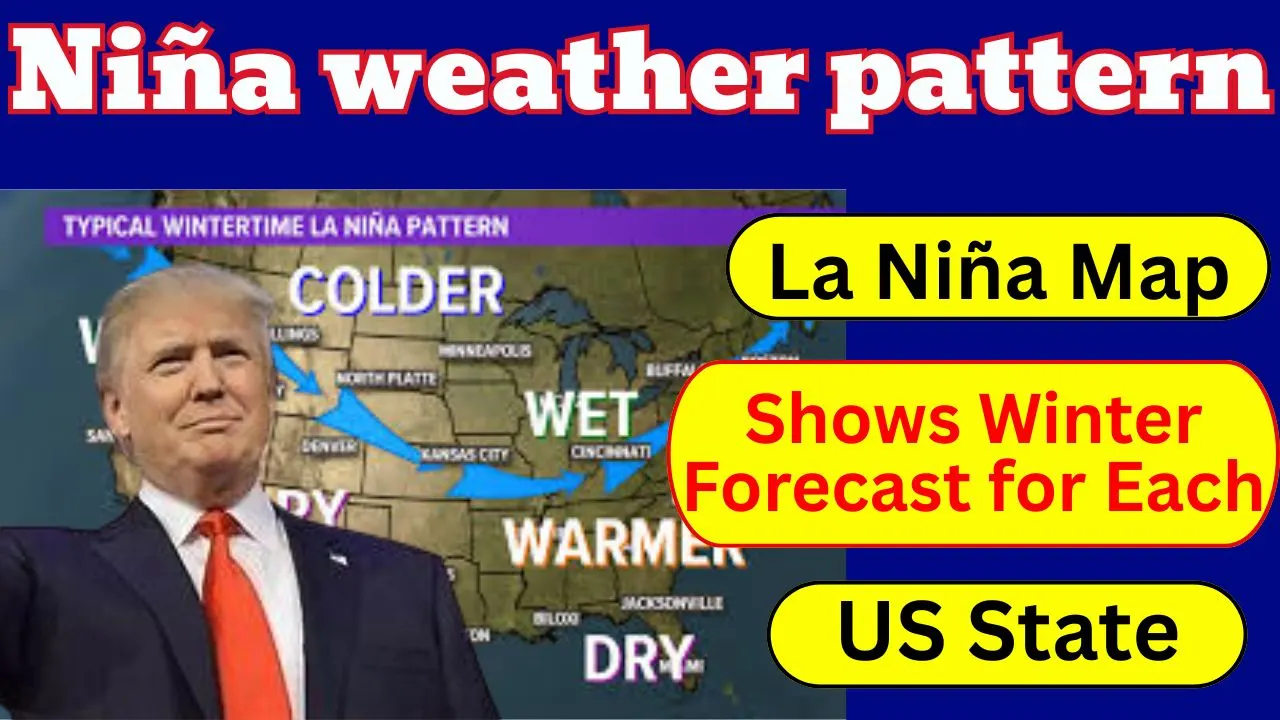As winter 2025 approaches, all eyes are on the La Niña winter forecast, which is shaping up to influence weather across the entire United States. According to the Climate Prediction Center (CPC), there is a 71 percent chance that La Niña conditions will take hold between October and December. This means changes in temperature and precipitation patterns are highly likely, and knowing what to expect can help you plan ahead for heating, travel, and even holiday activities.
The La Niña winter forecast is about much more than temperatures. It gives valuable insights into how precipitation, snowfall, and drought conditions may shift from state to state. With the CPC already publishing new maps for the 2025–2026 season, people across the country can begin to anticipate what their winter might look like, whether it means heavier rain, reduced snowfall, or milder temperatures.
La Niña Winter Forecast: What It Means for Your State
The La Niña winter forecast for October through December 2025 presents a varied outlook depending on where you live. For many states in the southern tier and parts of the Northeast, warmer-than-average temperatures are expected. Meanwhile, the Pacific Northwest and southern Florida are forecast to see wetter conditions compared to normal. These forecasts are based not just on ENSO signals but also on soil moisture, long-term climate trends, and atmospheric conditions.
For residents of the Southwest and southern Plains, the winter outlook indicates drier weather that could last well into early 2026. In contrast, states in the northern Rockies and Great Lakes region could see cooler air masses from time to time. Knowing these patterns now can help you prepare for travel, manage heating costs, and plan for outdoor or agricultural work.
Overview Table: La Niña Winter Forecast 2025 Snapshot
| Region/State Group | Forecast Highlights (Oct–Dec 2025) |
| Southwest (TX, NM, AZ) | Warmer temperatures, lower precipitation |
| Northeast (NY, CT, MA, VT, ME) | Above-average temperatures, shorter early snow season |
| Pacific Northwest (WA, OR) | More precipitation than normal |
| Southern Florida | Higher rainfall potential |
| Central Plains (KS, OK, NE) | Drier weather with limited rainfall |
| Gulf States (LA, MS, AL) | Mild temperatures and reduced rain |
| Northern Rockies and Plains | Cooler air possible in November |
| Midwest (IL, IN, OH) | Slight warming with periodic cool fronts |
| Great Lakes Region | Above-normal temperatures, mixed precipitation |
| California | Coastal areas could see moisture, interior zones remain drier |
Why It Matters
La Niña is part of the El Niño–Southern Oscillation (ENSO) cycle and occurs when cooler-than-average waters form in the central Pacific Ocean. This seemingly distant change disrupts jet streams and storm patterns, influencing weather across North America. The La Niña winter forecast matters because it directly impacts heating needs, travel safety, crop planning, and water supply management. Even a weak La Niña event can shift weather patterns enough to affect communities and businesses, while a stronger event can bring more dramatic changes.
This year, forecasters expect a weaker La Niña, but its effects may still be widespread. By aligning jet streams farther north, La Niña often results in wetter conditions for the Pacific Northwest and drier conditions for the southern states. For the Northeast and Midwest, the impact can vary, but early signs point to warmer conditions with fewer early snow events.
What To Know
According to the CPC’s latest maps, most of the United States is expected to experience above-average temperatures from October to December 2025. This includes large areas of the South, Northeast, and Midwest. States like Texas, Arizona, and New Mexico are forecast to be both warmer and drier than normal, raising concerns about ongoing drought conditions.
On the other hand, southern Florida and the Pacific Northwest are projected to have above-average rainfall. This could provide relief to some areas but may also increase the risk of localized flooding. In the Northeast, including New York, Connecticut, Rhode Island, Massachusetts, Vermont, New Hampshire, and Maine, higher-than-average temperatures may shorten the snow season and delay the arrival of winter storms.
What People Are Saying
AccuWeather forecasters agree with CPC predictions for widespread warmth in October but add that some cooling is likely mid-month across the northern Rockies and Plains. This could briefly interrupt warmer patterns and bring colder air into the Midwest. November may see more of these cool fronts moving through the region, although December is expected to show a stronger La Niña signature with warmer and drier conditions dominating the southern Plains and East Coast.
Experts also caution that because this is likely to be a weaker La Niña event, other climate factors could interfere with its effects. Arctic air outbreaks, for instance, may still push southward at times, creating variability in temperature and precipitation patterns.
What Happens Next
The Climate Prediction Center updates its seasonal outlooks on the third Thursday of each month, meaning the forecasts will continue to be refined as new data comes in. These updates consider ocean temperatures, atmospheric circulation, and broader climate trends to improve accuracy. While La Niña is the main driver of these forecasts, it is not the only influence on winter weather, so staying informed can help you plan more effectively.
How This Affects You
- Southern and Southwestern States: Expect warmer and drier conditions that could reduce heating costs but increase drought risks.
- Pacific Northwest and Southern Florida: Prepare for higher-than-normal rainfall, which may benefit reservoirs but also increase flood potential.
- Midwest and Northern Rockies: Look for a more unpredictable season, with some cold snaps but generally milder temperatures overall.
- Northeast: Warmer early-season temperatures could limit snowfall through November and early December.
- Great Lakes Region: Mixed conditions expected, with above-normal temperatures but uncertain precipitation patterns.
Final Thoughts
The La Niña winter forecast for 2025 provides a detailed look at how weather patterns may shift across the U.S. in the months ahead. From warmer conditions in the South and Northeast to wetter weather in the Northwest and Florida, La Niña is once again influencing the nation’s winter outlook. These forecasts are a vital planning tool, but they are not unchangeable. Weather patterns can shift as other climate factors come into play.
Staying updated through the Climate Prediction Center and local weather services can help you prepare for whatever this winter brings, whether it is unseasonable warmth, heavy rains, or unexpected snow events.
FAQs
La Niña is a climate pattern where cooler ocean temperatures in the Pacific shift jet streams, influencing rainfall and temperatures across the U.S.
The Climate Prediction Center says there is a 71 percent chance of La Niña conditions developing from October to December 2025.
The southern U.S., parts of the Northeast, and much of the Midwest are expected to see above-average temperatures early this winter.
Yes, in some areas. Warmer conditions in the South and Northeast may limit early snowfall, though the Northwest and mountain regions may still get heavy snow.
Yes. Seasonal forecasts are updated monthly and may shift as new data about ocean and atmospheric conditions becomes available.







